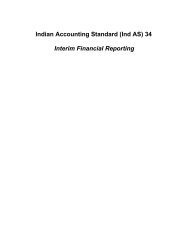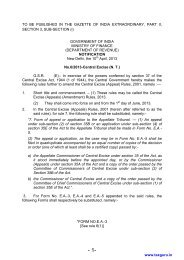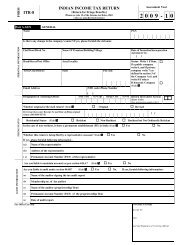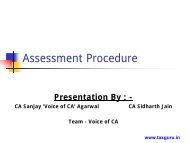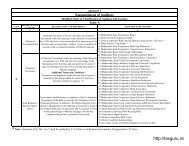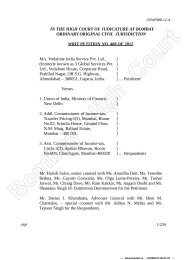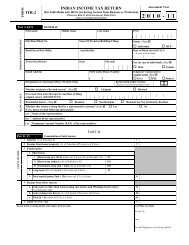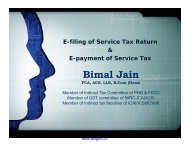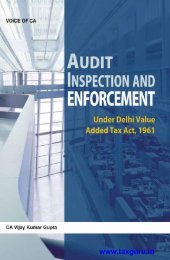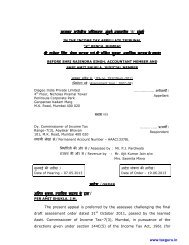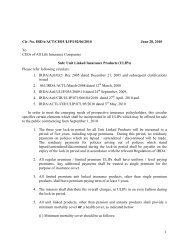ITR-3 INDIAN INCOME TAX RETURN - TaxGuru
ITR-3 INDIAN INCOME TAX RETURN - TaxGuru
ITR-3 INDIAN INCOME TAX RETURN - TaxGuru
Create successful ePaper yourself
Turn your PDF publications into a flip-book with our unique Google optimized e-Paper software.
(b) In case of an individual, for “employer category”, Government category will include Central Government/ StateGovernments employees. PSU category will include public sector companies of Central Government and StateGovernment;(c) The code for sections under which the return is filed be filled as per code given in instruction No.9(i).(d) In case the return is being filed by you in a representative capacity, please ensure to quote your PAN in item “PAN ofthe representative assessee”. In case the PAN of the person being represented is not known or he has not got a PAN inIndia, the item for PAN in the first line of the return may be left blank. It may please be noted that in the first line ofthis form, the name of the person being represented be filled.14. SCHEDULES(a) Schedule-S-In case there were more than one employer during the year, please give the details of the last employer. Further, incase, there were more than one employer simultaneously during the year, please furnish the details of theemployer you have got more salary. Fill the details of salary as given in TDS certificate(s) (Form 16) issued bythe employer(s). However, if the income has not been computed correctly in Form No. 16, please make thecorrect computation and fill the same in this item. Further, in case there were more than one employer during theyear, please furnish in this item the details in respect of total salaries from various employers.(b) Schedule-HP,-In case, a single house property is owned by the assessee, which is self-occupied and interest paid on the loan taken forthe house property is to be claimed as a deduction. This schedule needs to be filled up. If there are two or more than twohouse properties, fill out the details for each properties in this Schedule. If there are more than two house properties, thedetails of remaining properties be filled in a separate sheet in the format of this Schedule. and attach this sheet with thisreturn. The results of all the properties have to be filled in last row of this Schedule. Following points also need to beclarified,-(i)(ii)(iii)Annual letable value means the amount for which the house property may reasonably be expected to letfrom year to year, on a notional basis: Deduction for taxes paid to local authority shall be available only ifthe property is in the occupation of a tenant, and such taxes are borne by the assessee and not by the tenantand have actually been paid during the year.Deduction is available for unrealized rent in the case of a let-out property. If such a deduction has beentaken in an earlier assessment year, and such unrealized rent is actually received in the assessment year inquestion, the unrealized rent so received is to be shown in item 3a of this Schedule.Item 3b of this Schedule relates to enhancement of rent with retrospective effect. Here mention back years’extra rent received thereon, and claim deduction @ 30% of such arrear rent received.(c) Schedule-IF,-(i) This Schedule has to be filled for each firm in which you are partner.(ii) In case you are partner in more than 5 firms, a separate sheet may be enclosed giving the details in sameformat.(iii) In column (i) of the Schedule, furnish the amount of share in the profit of the firm (amount of profit) ascomputed in accordance with the provisions of the Income-tax Act in case of the firm. Such share is exemptfrom tax in hands of the partner.(iv)In column (ii), please furnish the amount of capital balance (including the capital on which you are entitledfor an interest) in the firm in which you are partner.(d) Schedule-BP,-(i) The details of the salary, bonus, commission, remuneration or interest received by you from the firms inwhich you are partner (filled in Schedule-IF are to be filled in this Schedule).(ii) The expenses, if any, relating to earning of such income (which have not been deducted while computingsuch income) shall be filled in column v of this Schedule.(e) Schedule-CG,-(i)(ii)If more than one short-term capital asset has been transferred, make the combined computation for all theassets. Similarly, make the combined computation for all the assets if more than one long-term capital assethas been transferred.For computing long-term capital gain, cost of acquisition and cost of improvement may be indexed, ifrequired, on the basis of following cost inflation index notified by the Central Government for thispurpose.(iii)Sl.No. Financial Year Cost Inflation Sl.No. Financial Year Cost Inflation IndexIndex1. 1981-82 100 15. 1995-96 2812. 1982-83 109 16. 1996-97 3053. 1983-84 116 17. 1997-98 3314. 1984-85 125 18. 1998-99 3515. 1985-86 133 19. 1999-00 3896. 1986-87 140 20. 2000-01 4067. 1987-88 150 21. 2001-02 4268. 1988-89 161 22. 2002-03 4479. 1989-90 172 23. 2003-04 46310. 1990-91 182 24. 2004-05 48011. 1991-92 199 25. 2005-06 49712. 1992-93 223 26. 2006-07 51913. 1993-94 244 27. 2007-08 55114. 1994-95 259 28. 2008-09 582Sections 54/ 54B/ 54D/ 54EC/ 54F mentioned in this schedule provides exemption on capital gains subjectto fulfillment of certain conditions. Exemption under some of these sections is available only in respect of





